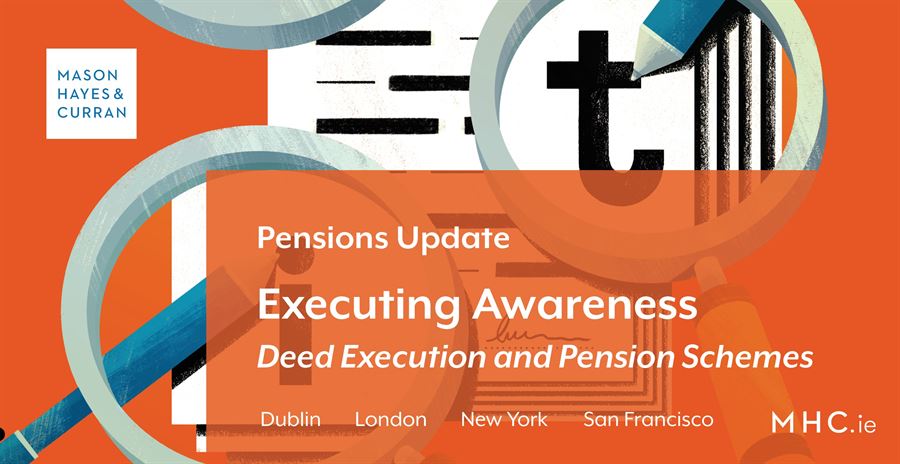
In a recent insight, we discussed the case of BIC UK Ltd v Burgess & Others and the importance of consulting a pension scheme’s documentation to ensure that the formal requirements of the trust deed and rules are adhered to so as to give effect to any decisions of the trustees or the employer. We will develop this theme here, with a focus on case law from Ireland and the UK that provide guidance on deed execution.
Briggs vs Gleeds (UK)
The Gleeds case involved the analysis of a number of documents relating to a pension scheme that was established in the 1970s. It was found that the partners’ signatures on numerous deeds had not been witnessed as required by UK property legislation and on that basis the judge ruled that none of the deeds had been validly executed. The employer had asked Judge Newey to consider allowing reliance on estoppel, but as the documents did not comply with the correct execution requirements he found that estoppel could not be invoked.
The deeds were put in place over the course of a number of years with the purpose of giving effect to various agreed changes to the scheme such as a reduction in accrual rates and closure of the scheme to future accrual. The failure of the partners to ensure that the deeds were correctly witnessed meant that much of those changes had never been affected. The judgement had expensive implications for the employer.
Ken Fennell vs Ben Gilroy & Ors (Ireland) and Irish legislation
In the Fennell case, the validity of a receiver’s deed of appointment was queried by the defendant. The case involved an application for an injunction by a receiver against Mr. Gilroy entering or taking possession of a property amongst other requests. Mr. Gilroy submitted that as the deed of appointment of the receiver had been executed under seal by the bank, it was not in compliance with the requirements of s24 of the Conveyancing Act 1881 which states that the appointment of a receiver by a bank is to be executed “in writing under its hand”. The Court found that as the two bank signatories had been authorised to execute deeds of appointment and witness the bank’s seal that its validity was not affected by the 1881 Act. While there was no express authority, the bank had been aware that the signatories were acting in this capacity on the bank’s behalf for some time and it had subsequently passed a resolution ratifying the authority of both signatories. While the judgment on this occasion was favourable for the bank, the case is an indication of the level of scrutiny that is often brought to bear on document execution in proceedings.
The Land and Conveyancing Law Reform Act 2009 also introduced deed execution requirements for individuals and corporates. For individuals, correct execution requires the signature to be witnessed. For companies, execution must be completed in accordance with its articles of association or constitution. Invariably, this will involve the application of the company seal to the deed which will need to be witnessed by two authorised signatories; the signatories are typically two directors of the company or one director and the company secretary acting with specific authority from the company’s board to execute the relevant documents.
While the Fennell case relates to property law and the insolvency process, it is nonetheless very relevant for trustees and employers as is the Gleeds case. In every instance where new deeds require execution the requirements of all relevant legislation and the existing scheme documentation should be reviewed and complied with. Any corporations, be it the employer or a corporate trustee, should also need to ensure that the individuals executing the deed(s) on its behalf are specifically authorised to do so.
General requirements for execution of a trust deed
In the majority of instances, a pension scheme’s sponsoring employer will be a company. In that case the execution formalities set out in company’s constitutional document(s) will need to be adhered to and the correct signature block should be included in the trust deed to accommodate the employer’s execution. In many cases the scheme will also have two or more individual trustees and each trustee will need to execute the trust deed in accordance with their own specific formalities.
Conclusion
Legal advice and guidance should be taken in every instance where new or amending scheme documentation is required. Once a trust deed is correctly executed and dated there will be certainty as to the current provisions of the scheme. As can be seen from the Gleeds case, getting this wrong can have a domino effect in respect of any subsequent documentation which is also executed incorrectly or executed in reliance on a previous but invalid deed. These errors are likely to prove very costly for employers and scheme members.
For more information on the preparation and execution of a pension’s trust deed and rules to, contact a member of our Pensions team.
The content of this article is provided for information purposes only and does not constitute legal or other advice.






